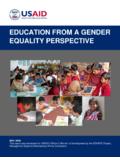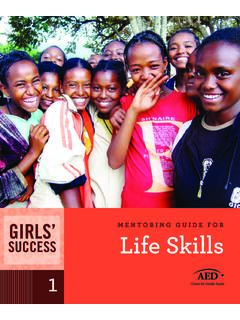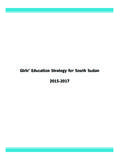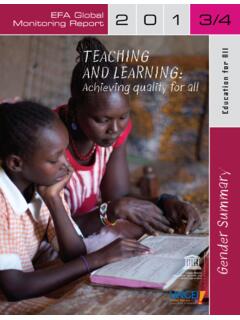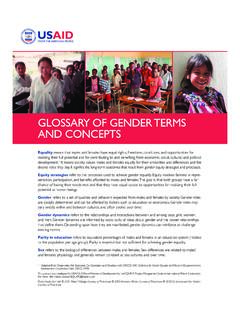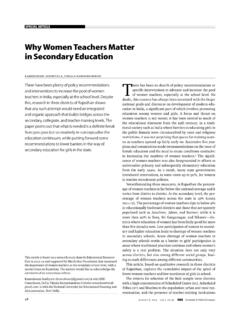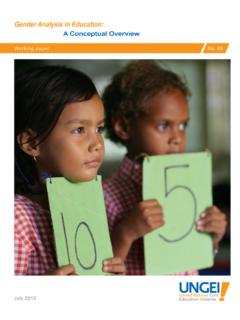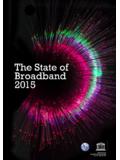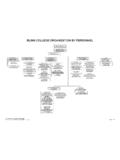Transcription of MEASURING GENDER INEQUALITY IN EDUCATION …
1 MEASURING GENDERINEQUALITY IN EDUCATIONIN SOUTH ASIAE laine UnterhalterTitles in this SeriesThe Move to Programme-Based Approaches An Effective Partnership for Girls' EDUCATION ?The Experience of Recent EvaluationsTed FreemanEducating Girls in South Asia: Promising ApproachesBarbara HerzReaching the Girls in South Asia: Differentiated Needs and Responses in EmergenciesAlexandra MathieuMainstreaming GENDER for Better Girls' EDUCATION : Policy and Institutional IssuesRamya SubrahmanianMeasuring GENDER INEQUALITY in EDUCATION in South AsiaElaine UnterhalterAddressing Social and GENDER Disparity in South Asia Through SWAps and PBAsin EDUCATION : How Can We Use World Experience?Amanda SeelMEASURING GENDERINEQUALITY IN EDUCATIONIN SOUTH ASIAE laine UnterhalterSenior Lecturer, Institute of EDUCATION Universityof London, UK The United Nations Children's Fund (UNICEF)Regional Office for South Asia; andUnited Nations Girls' EDUCATION Initiative (UNGEI)October, 2006 Short excerpts from this paper may be reproduced for non-profit purposes without authorizationon condition that the source is acknowledged.
2 For longer extracts, permission in advance must beobtained from the copyright holders via email at opinions expressed in this paper are those of the author(s) and publication does notnecessarily constitute an endorsement by UNICEF or , Steering Committee: Susan DurstonUNGEI: Raka RashidSeries Editor: John EvansFeedback and correspondence photo: UNICEF/Bangladesh/SHEHZAD NOORANID esign and Colour Separations: DigiScan Pre-press, Kathmandu, NepalPrinting: Format Printing Press, Kathmandu, 12. Measures of GENDER Equality in 3 Three Current 3 Gross and Net Enrolment Ratios (GER and NER).. 3 GENDER -related EFA Index (GEI).. 5 Attendance and 7 UNESCO EDUCATION Development Index (EDI).
3 83. Increases in Enrolment and GENDER Parity in South Asia Further 104. GENDER Equality in EDUCATION Index (GEEI) .. 14 Towards an Alternative 14 The Beyond Access 16 What Does The GEEI Tell Us?.. 185. 20ivMeasuring GENDER INEQUALITY in EDUCATION in South 25 About the 27vMeasuring GENDER INEQUALITY in EDUCATION in South AsiaSERIES FOREWORDT here is a growing sense of momentum around EDUCATION in South are engaged and a lot has been done. The Millennium DevelopmentGoals have added an additional spur to action as indeed have greater awarenesson GENDER disparity and the need for educated workers. There is though a longway to go if the rights of all children are to be access to EDUCATION is only part of the story.
4 Once children are enrolledand attending, the quality of their EDUCATION must make it a worthwhileexperience. The special needs of girls in the social and cultural context of SouthAsia call for special measures, as do the needs of all children in situations ofconflict and emergency. South Asia has many rich, positive examples of successin advancing basic EDUCATION . It is important that these are shared and built on ifthere is to be an overall improvement throughout the series of papers aimed at promoting better EDUCATION in South Asia grew outof collaboration between the UNICEF Regional Office for South Asia and thenewly formed UN Girls' EDUCATION Initiative, and had its genesis at a RegionalMeeting on Accelerating Girls' EDUCATION in South Asia in February the series is intended to be a forum that allows debate, exchange ofideas and to break new ground.
5 It will aim to capture the momentum and extolgood practice to all engaged in educational policy and GENDER INEQUALITY in EDUCATION in South AsiaThe series does not seek to represent a specific viewpoint, but rather is intendedto enable specialist contributors to present issues in greater depth and breadththan is often the case in official the series will focus on girls' EDUCATION but it is hoped that eventually itwill broaden into a platform for more general EDUCATION issues related to SouthAsia, with a particular emphasis on social inclusion. Contributions and feedbackare invited from academics and practitioners from throughout the South Asiaregion and beyond.
6 The series editors are particularly interested in submissionswhich offer new ideas and strategies that can assist those needing answers, andwhich can add impetus to the ongoing efforts in the region to provide qualityeducation for , join the debate!viiMeasuring GENDER INEQUALITY in EDUCATION in South AsiaACKNOWLEDGEMENTSThis paper is based on work commissioned from the Beyond Access project in2004 05 by the Commonwealth Secretariat, UNESCO Bangkok and UNICEFR egional Office for South Asia. It develops and adapts ideas set out inUnterhalter, Rajagopalan and Challender (2005) and Unterhalter and McCowan(2005). I am grateful to all three commissioning organizations for permission topublish this paper, which draws on reports prepared for are due to Joseph Crawford and Jacob Steel for help in developing theformula for calculating the GEEI and to Tristan McCowan for research GENDER INEQUALITY in EDUCATION in South AsiaSUMMARYThis paper assesses current measures for GENDER equality in EDUCATION .
7 Whilegender disaggregating enrolment and progression data has been an importantstep forward, measures that are concerned only with the presence or absence ofgirls in school provide little insight into aspects of GENDER inequalities withinschools or the gendered environment beyond school. Nevertheless, suchmeasures do generally show improvement for nearly all the countries in SouthAsia for which there is measures of EDUCATION quality underplay the significance of genderequality as an aspect of quality. In reviewing economic and GENDER indicatorstogether with EDUCATION indicators for South Asia, no consistent pattern paper presents the GENDER Equality in EDUCATION Index (GEEI) a measuredeveloped to draw on existing data sources to consider GENDER equality ineducation in more dimensions than simply enrolments.
8 The GEEI for thecountries in South Asia for which there is data shows that gains were made overthe 1990s in all countries except Pakistan. However, to reach a GEEI scoreconsonant with achieving the GENDER and EDUCATION MDGs will require sustainingthe huge mobilization of the previous decade and in many countries increasingthis. The assessment of GEEI gives some indication of the size of the task andthe levels of mobilization GENDER INEQUALITY IN EDUCATION IN SOUTH ASIAINTRODUCTION1 Millennium Development Goal 3 forgender equality and the empowerment ofwomen is the goal that was set with theearliest date for achievement thinking behind this was that thepersistence of GENDER inequalities wouldundermine all the other MillenniumDevelopment Goals (MDGs).
9 GENDER unlike class, race, ethnicity or disability is one form of social division commonto all societies across the GENDER INEQUALITY is anindicator of commitment to theprinciples that underlie all the MDGs,that is that each and every person on theglobe is the subject and object of moralconcern for the whole population andthat we accord each other reciprocalrespect so that each of us may live a lifeof dignity, without suffering or harm,particularly with regard to poverty,hunger, ill health, lack of EDUCATION ,discrimination, or the consequences ofenvironmental target associated with MDG3 was anend to GENDER disparities in primary andsecondary EDUCATION .
10 We know now thatthis target has been missed in 94 out of149 countries for which data isavailable (UNESCO, 2005). This is amatter of grave concern. It is shamefulin a world where huge wealth isamassed, where enormous talents exist,together with great eagerness foreducation, that in five years we have notbeen able to enrol equal numbers ofgirls and boys in school and ensure thatequal numbers pass just five grades. Ifwe miss the target for this first MDG arewe not calling into question the wholeproject? I fervently hope we are not. Itrust that the fact that we have missedthe first MDG is a wake-up call to us all2 MEASURING GENDER INEQUALITY IN EDUCATION IN SOUTH ASIAto think better, discuss deeper, and putthe insights we distil into paper analyses the progress thathas been made in relation to MDG3 andgives some pointers as to whatprocesses have been associated withthat progress.
